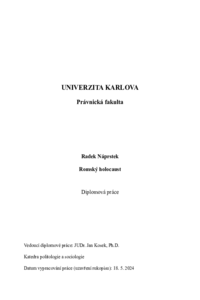Romský holocaust
The Roma (Gypsi) Holocaust
diploma thesis (DEFENDED)

View/
Permanent link
http://hdl.handle.net/20.500.11956/191328Identifiers
Study Information System: 253787
Collections
- Kvalifikační práce [14207]
Author
Advisor
Referee
Agha, Petr
Faculty / Institute
Faculty of Law
Discipline
Law
Department
Department of Politology and Sociology
Date of defense
19. 6. 2024
Publisher
Univerzita Karlova, Právnická fakultaLanguage
Czech
Grade
Very good
Keywords (Czech)
romský holocaust, menšinová práva, dějiny a právní postavení RomůKeywords (English)
Roma holocaust, minority rights, history and legal status of RomaNázev práce: Romský holocaust Abstrakt: První část diplomové práce se snaží Romy čtenáři představit. Zaměřuje se na jejich původ, způsob života, zaměstnání, jež v minulosti vykonávali, a rovněž na jejich pojmenování v různých jazycích. Druhá část se soustředí na vybrané instance perzekuce Romů v historii. Podrobněji popisuje antiromské asimilační předpisy vydané za vlády Marie Terezie a jejího syna Josefa II. a také velký proticikánský zátah ve Španělsku v 18. století. Třetí část pojednává o československém zákonu o potulných cikánech vydaném v roce 1928. Soustředí se na historické okolnosti jeho přijetí, analýzu jeho znění a na jeho kritiku z úst tehdejších poslanců. Čtvrtá část cílí na cikánské tábory v Letech u Písku a v Hodoníně u Kunštátu. Zejména pak na rozbor vládních nařízení, na jejichž základě fungovaly, na vznik tábora, jeho správu a fungování, každodenní život vězňů a také na nově vybudovaný památník na území bývalého letského tábora. Pátá část popisuje cikánský tábor v Osvětimi. Podrobněji se zabývá jeho vznikem a popisem, jakož i fungováním a správou, ale také životem a smrtí vězněných Romů. Šestá část pojednává o rasistické filozofii 19. a 20. století a jejím vlivu na nacistickou ideologii. Zabývá se především pojmy rasa, sociální darwinismus a rasová hygiena. Sedmá část je zaměřena...
1 Abstract The title of the thesis: Roma holocaust Abstract: The first part of this thesis attempts to introduce the Roma to the reader. It focuses on their origins, their way of life, the jobs they have held in the past and their names in different languages. The second part focuses on selected instances of persecution of Roma in history. It describes in detail the anti-Roma assimilation regulations issued during the reign of Maria Theresa and her son Joseph II, as well as the great Gypsy round-up in Spain in the 18th century. The third part deals with the Czechoslovak law on wandering gypsies, issued in 1928, focusing on the historical circumstances of its adoption, an analysis of its text and criticism of it from the MPs of the time. The fourth part focuses on the gypsy camps in Lety u Písku and Hodonín u Kunštátu. In particular, it analyses the government regulations under which they operated, the establishment of the camp, its administration and functioning, the daily life of the prisoners and the newly built memorial on the grounds of the former Lety camp. The fifth part describes the Gypsy camp at Auschwitz. It deals in detail with its origins and description, as well as its functioning and administration, and also the life and death of the imprisoned Roma. The sixth part deals with 19th and 20th...
